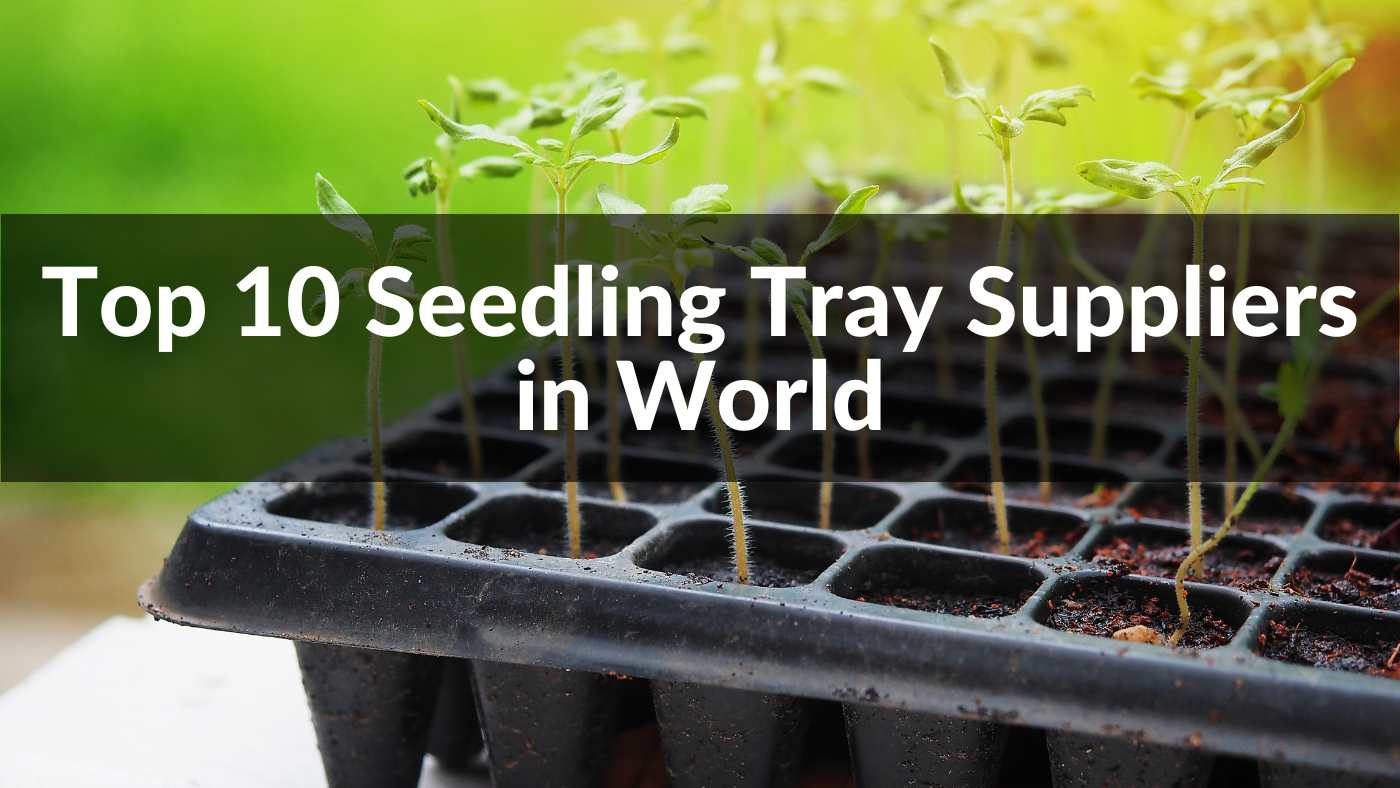
Are you confused about the multitude of options available when it comes to choosing the right trays for microgreens and propagation? Worry not, because we have got you covered. In this comprehensive guide, we will delve into the details of the various types of seedling trays, including mesh trays, trays with holes, and more, helping you make the most informed decision for your gardening needs.
Do I Need Seedling Tray with Holes and Without Holes to Grow Microgreens and Soil Blocks?
Which Seedling Trays Are Best for Growing Microgreens Commercially?
Which Seedling Trays Are Best for Growing Microgreens at Home?
What Is the Difference Between Mesh Trays and Trays with Holes?
Should I Use Shallow Trays or Deep Trays for Growing Microgreens?
When venturing into the world of gardening, the choice of seedling trays can significantly impact the success of your microgreens and propagation efforts. As a manufacturer, we've seen an array of trays and understand the nuances that differentiate them. The industry is saturated with various types, but we'll simplify the options to help you make an informed decision.
Firstly, let's talk about the classic seedling tray. These are the foundational tools in any gardener's arsenal. With their spacious design, they allow for an optimal spread of seedlings, ensuring each gets the right amount of sunlight and space to thrive. Our range includes options from different materials, each catering to specific needs.
Then we have the innovative seedling trays with holes. These are a game-changer, especially for those dealing with water-sensitive plants. The holes provide excellent drainage, preventing water logging and the potential risks of mold and mildew. It’s not just about functionality; our designs also prioritize aesthetics, ensuring your trays complement the beauty of your green sanctuary.
Next on the list are mesh trays. These are a popular choice for microgreens and small-scale propagations. The mesh design promotes air circulation, crucial for the healthy development of roots. We pride ourselves as a top seedling tray manufacturer, offering durable and versatile mesh trays that cater to both professional gardeners and hobbyists alike.
Lastly, let's not forget the variety of sizes and shapes available. From large trays for extensive gardens to small, compact options for windowsill setups, we have a tray for every need. The diversity in our catalog reflects our commitment to catering to a wide range of customers, ensuring everyone finds their perfect match.
You might be wondering, "Do I really need different types of seedling trays to grow my microgreens and soil blocks?" The short answer is yes, and let me tell you why.
Let's start with microgreens. These tiny greens are packed with nutrients and are a popular choice for both home gardeners and professional chefs. When it comes to growing microgreens, proper drainage is key. This is where seedling trays with holes come in. The holes allow excess water to drain away, preventing the roots from sitting in water and potentially developing rot or mold. So, in this case, seedling trays with holes are your best bet.
Now, let's talk about soil blocks. Soil blocks are a sustainable alternative to traditional potting methods. They are essentially small blocks of compressed soil that are used to start seeds. When growing soil blocks, you don't necessarily need a tray with holes. However, having a tray without holes can be beneficial as it will contain the moisture and keep your soil blocks from drying out too quickly. That being said, it's important to monitor the moisture levels to prevent overwatering.

When it comes to microgreen trays, size does matter! But don't worry, finding the perfect size is not as complicated as you might think.
The first thing to consider is the amount of space you have available. Do you have a sprawling backyard, a cozy balcony, or a sunny windowsill? This will largely dictate the size of the tray you should opt for. For those with limited space, smaller trays are the way to go. They are compact, easy to manage, and can be placed just about anywhere. On the other hand, if you have ample space, larger trays will allow you to grow more microgreens in one go.
Next, think about the variety of microgreens you want to grow. Some microgreens have larger leaves and require more space to thrive, while others are smaller and can be grown closer together. It's important to research the specific needs of the microgreens you are interested in and choose a tray that will accommodate them.
Lastly, consider the depth of the tray. Microgreens do not have deep roots, so a shallow tray is usually sufficient. However, if you plan on growing multiple crops in the same tray, a deeper tray may be necessary to accommodate the growing medium and roots.
Growing microgreens commercially is an exciting venture that requires the right tools for success. One of the most essential tools is, of course, the seedling tray. But with so many options on the market, which trays are the best for commercial microgreen farming?
First and foremost, durability is key. Commercial farming can be tough on equipment, so you want trays that can withstand the rigors of daily use. Our seedling trays are made from high-quality materials that are built to last, ensuring you get the most bang for your buck.
Size also matters when it comes to commercial farming. Larger trays allow you to grow more microgreens in one go, maximizing your yield and profits. Our range includes a variety of sizes to suit your specific needs, from small trays for specialized crops to large trays for mass production.
Next, let's talk about functionality. Seedling trays with holes are a must for microgreens, as they provide excellent drainage and prevent waterlogging. This is especially important for commercial farmers who can't afford to lose an entire crop due to poor drainage. Our trays with holes are designed to provide the perfect balance of drainage and moisture retention, ensuring your microgreens thrive.
Lastly, consider the ease of cleaning and sanitizing the trays. In commercial farming, hygiene is paramount to prevent the spread of disease. Our trays are easy to clean and can be sanitized between uses, ensuring your crops are always grown in a clean and healthy environment.

If you're looking to jump on the microgreens bandwagon and start growing these nutrient-packed greens at home, you're in the right place. The first step in your microgreen journey is to select the right seedling tray. But with so many options available, how do you choose the best one?
First and foremost, consider the size of the tray. For home growers, a smaller tray is often the most practical option as it can easily fit on a windowsill or a small shelf. Our seedling trays come in a range of sizes, so you're sure to find one that fits your space perfectly.
Next, think about the depth of the tray. Microgreens have shallow roots, so a shallow tray is usually sufficient. However, if you plan on growing multiple crops in the same tray, a deeper tray may be necessary to accommodate the growing medium and roots. Our range includes both shallow and deep trays, giving you the flexibility to grow a variety of microgreens.
In terms of material, plastic trays are a popular choice for home growers due to their affordability and durability. Our plastic seedling trays are made from high-quality materials that are built to last, ensuring you get the most value for your money.
Lastly, consider the ease of cleaning and sanitizing the tray. It's important to keep your growing environment clean to prevent the spread of disease. Our trays are easy to clean and can be sanitized between uses, ensuring your microgreens are always grown in a clean and healthy environment.
The answer to whether you need both trays with holes and trays without holes depends on what you're looking to achieve with your microgreens or seedlings. Let's dive into the benefits and uses of both types of trays to help you make the best decision for your needs.
Trays with holes are essential for proper drainage. They help to prevent waterlogging by allowing excess water to escape, which is crucial for the health of your microgreens and seedlings. This type of tray is perfect for those who tend to overwater or live in humid climates where moisture can be an issue.
On the other hand, trays without holes can be useful for maintaining a more controlled watering environment. Since the water can't escape, you have more control over the moisture levels in the soil, which can be beneficial in dry climates or for those who prefer a more hands-on approach to watering. These trays are also great for bottom watering, where water is absorbed from the bottom up, ensuring the roots get the moisture they need without disturbing the soil or seedlings.

When it comes to growing microgreens and other seedlings, the type of tray you use can make a big difference. Two popular options are mesh trays and trays with holes. While they may seem similar, there are some key differences that set them apart.
Mesh trays are made from a fine mesh material that provides excellent drainage while also allowing air to circulate around the roots. This is crucial for preventing root rot and other fungal diseases that can occur in moist conditions. The fine mesh also helps to keep small seeds from falling through, making it an ideal option for growing microgreens and other small-seeded plants.
Trays with holes, on the other hand, are typically made from plastic and have larger holes for drainage. While they still provide good drainage, they may not be suitable for small-seeded plants as the seeds can fall through the holes. These trays are a good option for larger seedlings and plants that require more water, as the larger holes allow for more water to drain away quickly.
Soil blocking is a unique method of starting seedlings where the soil is compressed into blocks that stand alone, with no need for a container. When it comes to selecting the right seedling tray for soil blocking, there are a few key factors to consider.
Firstly, you'll want to look for trays that are sturdy and durable. Soil blocks can be quite heavy, especially when wet, so a strong tray is essential to support the weight of the blocks. Our range of seedling trays is made from high-quality materials that are designed to withstand the demands of soil blocking.
Next, consider the size of the tray. Soil blocks can vary in size, so it's important to choose a tray that is large enough to accommodate the blocks without crowding. Our seedling trays come in a range of sizes, giving you the flexibility to choose the perfect tray for your needs.
Mesh seedling trays are a versatile tool for any gardener or farmer looking to optimize their growing conditions. So, what exactly are these trays used for? Let's explore the various applications of mesh seedling trays.
Firstly, mesh seedling trays are fantastic for promoting optimal drainage. The mesh design allows excess water to drain away easily, preventing waterlogging and root rot. This is especially important for small seeds and seedlings that are sensitive to overly wet conditions.
Another significant advantage of mesh seedling trays is their ability to promote air circulation around the roots. Good air flow is essential for the health of your plants, as it helps to prevent mold and other diseases that can thrive in damp conditions.
Mesh trays are also ideal for small-seeded plants, as the fine mesh prevents seeds from falling through. This makes them perfect for growing microgreens, herbs, and other small-seeded crops.

Growing microgreens on screens in mesh seedling trays is a popular method among both home gardeners and commercial growers. The mesh tray provides excellent drainage, preventing waterlogging and root rot, which are common issues in microgreen cultivation.
When growing microgreens on screens, the small seeds are spread evenly over the screen, allowing them to germinate and grow through the mesh. This method is particularly advantageous because it promotes even watering and air circulation, both of which are crucial for healthy microgreen growth. The screen also makes it easy to harvest your microgreens, as you can simply cut them above the mesh, leaving the roots behind.
In addition to these benefits, using a mesh seedling tray also makes it easier to manage pests and diseases. The open design of the mesh allows for better observation and access to the plants, making it easier to spot and treat any issues before they become a problem.
The choice between shallow and deep trays for growing microgreens is an important one, as it can significantly impact the health and yield of your crops. Let's explore the pros and cons of each option to help you make an informed decision.
Shallow trays are generally considered the better option for growing microgreens. This is because microgreens have a short growing cycle and do not develop extensive root systems. Shallow trays are easier to manage, requiring less growing medium, and they allow for better air circulation around the roots. Additionally, shallow trays are typically lighter and easier to handle, making them a convenient option for both home gardeners and commercial growers.
However, there are also some situations where deep trays might be preferred. If you are growing larger varieties of microgreens that have longer growing cycles, a deep tray may be necessary to accommodate the more extensive root systems. Deep trays also allow for more consistent moisture levels, which can be beneficial in drier climates or during hot summer months.
Finding the right seedling tray manufacturer can be a daunting task, but it's crucial to ensure you get quality products that meet your needs. So, where should you start your search?
Firstly, you can ask for recommendations from fellow gardeners or farmers in your area. They may have worked with a manufacturer before and can provide valuable insights into the quality of their products and customer service. Online gardening forums and social media groups are also great places to ask for recommendations.
Another option is to search online. A simple Google search can reveal a list of seedling tray manufacturers in your area or around the world. Be sure to check out their websites and read customer reviews to get a sense of their reputation. Look for manufacturers that offer a range of products, have clear and detailed product descriptions, and provide excellent customer service.
Trade shows and agricultural expos are also great places to find seedling tray manufacturers. These events allow you to see the products in person, ask questions, and even negotiate deals on the spot.
When you've found a few potential manufacturers, don't hesitate to contact them and ask for samples. This will allow you to assess the quality of their products firsthand and make an informed decision.
In conclusion, the right seedling tray is crucial to the success of your microgreens or propagation project. With the variety of trays available, including mesh trays, trays with holes, and more, you are sure to find the perfect fit for your needs. And remember, when it comes to top-quality garden tools and seedling trays, look no further than China's leading manufacturer and trader, Linkwin. Visit their website at https://www.agriculturaltool.com to explore their extensive range of products and see how they can help take your garden to the next level.












We use cookies to make the website work, to provide advanced features, social media and traffic analysis, and we use analytics and third-party advertising cookies. If you choose to click "Deny All", you will retain the default setting of not allowing the use of cookies or other tracking tools other than technical tools.

